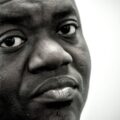Conversations: Allison Wyss and A.L. Rowser

Allison Wyss is the author of the short story collection, Splendid Anatomies, published by Veliz Books in March of 2022. The characters in her collection explore boundaries and refuse them. Some are fixated on what is real and therefore, they think, more likely to last. They contemplate not navels, but nutsacks—while floating in space. They reach for each other in a world made only of yogurt, where the self and other become like one. They modify their bodies or the bodies of others in more or less permanent ways—with tattoos, cosmetic surgery, transmogrification, or simply hacking off limbs. A metal detector becomes almost hardwired to a volunteer security guard when it runs out of batteries. An electrician can enjoy his evening bike ride only when outfitted with resilient, inflatable breasts. In the words of Maud Casey, “Each of these mesmerizing stories possesses its own splendid anatomy, reminding us with beautiful urgency that storytelling is how we feel our own existence.”
Allison’s short stories also appear in Southeast Review, Alaska Quarterly Review, Cincinnati Review, and Moon City Review, among other places. She teaches at the Loft Literary Center in Minneapolis, Minnesota and cofounded the Minneapolis Storytelling Workshop with fellow writer Erin Kate Ryan.
A.L. Rowser’s stories appear in Necessary Fiction, The Adroit Journal, Bourbon Penn, Storm Cellar, Orca, Tulip Tree Review, and elsewhere. She lives with her spouse and three cats in Southern California, where she may ghost for others when not writing as herself. Rowser first met Allison in the MFA program at the University of Maryland almost a decade ago.
A.L. Rowser: You’ve mentioned, probably more than once, but at least once in connection to your collection, that you believe we’re all cyborgs because of writing. I could follow that logic with using a laptop to write, for example, but that didn’t seem to be what you meant. Recently I read Ted Chiang’s short story, “The Truth of Fact, The Truth of Feeling,” in which he demonstrates through narrative how writing changes the way we think. So, now I’d like to hear more about how you see this working.
Allison Wyss: Even writing with a pen makes us cyborgs. We’re creating a brain outside of our brain. For example, if I write down a grocery list, I can let go of remembering individual items because I now have it in my hand. I don’t have to walk to the store remembering: I need milk, eggs, whatever. It frees up brain space.
AR: The paper becomes like an external hard drive for storing information.
AW: Yeah, and when I’m writing a story, I don’t have every word memorized. The only reason I can get to a stage later with it is because it’s written down and I can revisit it. The story comes from my imagination, but my imagination has to be built out on this other form, which is words—on a screen or on a piece of paper. If I didn’t have that, I couldn’t build the whole story, I don’t think.
AR: But people used to all the time, right?
AW: I think about the difference in written stories versus an oral tradition a lot because I write fairy tales. With oral storytelling, it’s not this static form—it’s dynamic. It spins out differently every time. But if you want a particular sort of complexity of character and multiple scenes fully painted, writing makes that a lot easier.
Cell phones make us cyborg too, both because they’re this remote brain and also because they’re also communication devices. They give us access to a whole community. And I think community is part of our bodies, too. I think the line of the body is arbitrarily decided at skin. But it’s not just skin. Your clothes are a part of your body. The chair that holds you becomes a part of your body. If you hold somebody’s hand, you merge in a way that’s gross, but also real. The bacteria crawling back and forth. Think about how we share colds, pheromones, and how we influence each other. Our bodies are really permeable.
AR: I found myself thinking a lot about cyborgs with characters in your collection. How do you see this concept playing out?
AW: The idea of taking technology specifically, but also any other thing, and making it a part of you is an extremely powerful way of claiming your own self. When you change your body in any way, I think it often becomes more you.
If you get a tattoo, or if you have cosmetic surgery, you become more authentically who you’re meant to be, or the self that you create, because you made that choice about your body. And sometimes maybe you get it wrong. But striving to make your body as truly your own as it can possibly be is glorious and worthwhile.
I worried it could be read as negative that characters were trying to do this in my collection. It’s really important to me that my stories read like the characters are fighting the good fight. Even if they lose.
AR: Of course, on the topic of cyborgs, Donna Haraway’s “A Cyborg Manifesto” comes to mind. Her concept of cyborgs had to do with embracing dualities rather than dichotomies, and interrogating boundaries. A key work linked to her philosophy is an interactive text, Patchwork Girl by Shelley Jackson. I remember you reading this during our MFA, and how intrigued you were by it.
AW: Patchwork Girl is just so, so weird. I can’t read it again. Like, my computer will no longer take the CD. It’s the kind of narrative where you click on a different link, and you get a different little bit of the story. I wanted the Hank story (“FastDog Security”) to be told that way.
I played around with structures more like a deck of cards, so sections would be randomized. Like the clutter could crash upon you in a different way every time you read it. There would be an opening scene and an ending scene, and everything in the middle could shuffle. But it wasn’t something that I could pull off in book form.
I love writing that takes a graphic form, and you can enter in different places and from different angles. Some of my strange structure is an attempt to mimic that.
AR: I noticed that kind of structure in “Roar,” “FastDog Security,” “You’re Perfect as You Are,” and even “Boobman.”
AW: I applied more external structures to some of those later. But the structure is the anxiety of the human being. It’s this voice that keeps coming back to this thing. The idea is that these characters can only wander so far away from the things that most freak them out, and then they have to come back, almost like swinging out and grabbing again for that bar. And that bar is the thing they’re most afraid of. The story could be told in a different order. It just has to keep coming back around. So that’s what I was thinking of with Hank, especially.
To go back to Patchwork Girl, the structure is around a body. Each body part is a different story, but we keep getting pulled back to this body that has the links on it. And that structure is really compelling to me. But you have to nail it down if you’re going to put it in a book. You have to say that this word comes first, this word comes second. It’s a chain of words.
At some point when you’re reading, the story takes off and you become immersed in it. You forget about reading the words, and you’re just in the room with the characters, right? There’s this point where that just goes away and somehow your eyes are still taking the words in, and in order, but you break that. I’m really fascinated with how stories create a deep experience that is not just that rope of a word at a time. That point where it becomes a space instead of a story.
AR: I’d like to talk about the first story to kick off the collection. At one point you’d thought about calling the collection You’re Perfect As You Are, which is also the title of that story.
AW: So, starting with this story, I get to have it as the first title. It’s still there up front, and hopefully the reader is now thinking about these ideas. While Ursula isn’t a particularly moral human being, she has decided who she wants to be. I think everybody probably does that, whether they’re making a good choice or a bad choice. She’s building her body around a piece of herself that she feels is authentic, and yet nothing is authentic. There is no such thing. Your authenticity is whatever you choose, rather than what your genes built for you or whatever.
AR: A number of your characters seem obsessed with what is authentic or real.
AW: My characters really want things to last, and they consider it a great tragedy that things won’t. So, they think of it like something real won’t slip away, right? Like the idea of what real art is, is that it will last. And this is an absurd idea. Or counting on something like a “perfect” nose when beauty standards are completely arbitrary.
AR: In “You’re Perfect As You Are,” the story title is also the plastic surgeon’s line. Not for Ursula, but for other people. But at the same time, the reader can see how he does use the line on her. And what I find particularly compelling about the story is how it interrogates pretty much everything without pinning anything down. There is this Roomba at work for a good portion of the story, physically traversing the boundaries of her new condo while she emails her realtor to really get granular about what it means if she paints a wall or how much of the hallway is actually hers.
All these things that you’re exploring in terms of boundaries, categories, self, identity and what’s real and isn’t—even what makes a good relationship. And by the end, we see that none of it is even remotely stable. The story works like that Roomba going around bumping into the wall then back out into the room again. Now she’s arranging the dishes, now she’s emailing her realtor, now she’s remarking on Dr. L and their relationship, on Dr. L’s wife.
These pieces come together and reference each other, yet they are constantly shifting. And I really like that—the way that you keep the boundaries fluid.
AW: In terms of putting the pieces together as a reader, I think that there’s a difference between being asked to hold facts and being asked to hold impressions or feelings—that sort of meaning. Stories that want me to hold on to facts give me a lot of anxiety. I feel like I’m supposed to remember all this stuff, and what I want to remember are impressions. And maybe some details will stick with me, and that’ll be great. But I want to stack up my wisdom rather than stack up my information. That’s how I want people to read my stories, too.
Utimately, I decided that the Ursula story was doing what I wanted to establish at the beginning of the collection. But I also really liked the idea of opening with the story “Only Real Art Lasts Forever” because that first paragraph has the bodies in pieces, you know? I really liked the idea of starting with that first paragraph of a naked body split by tattoos.
AR: Yeah, that makes sense. It’s also very reminiscent of Patchwork Girl.
AW: It’s interesting how much of an influence that really has been. When I discovered Patchwork Girl, it wasn’t like: Oh, this is it. I’m going to start writing this way! It was more like: the writer of this story, Shelley Jackson, understands what I’m trying to do and what I care about. Where are the borders of my body? I don’t know. But I’m going to keep defining them again and again and again. That feels like the way we live. It’s an aesthetic ideal that I’m interested in pursuing and exploring. So, yeah, it was absolutely inspirational.
But also, you know, ideas don’t come out of nowhere. They’re already in the world, right? None of my ideas are new. A lot of people are writing about bodies now, and that’s great. I love joining this conversation with other people writing about weird bodies. Stories are always a conversation. We’re always using language that’s been invented by other people, and we’re always evoking and alluding to things that have already been done. That’s what I think is really powerful about putting a story into the world—you get to answer those other stories and maybe somebody will answer yours.
AR: What other authors writing about bodies do you particularly admire or see yourself in conversation with?
AW: Carmen Maria Machado is the first one that comes to mind. And then Helen Oyeyemi, Kelly Link, Yoko Tawada, Lesley Nneka Arimah, Yukiko Motoya, Carter Meland and so many more whose work I return to again and again, especially when I teach. You mentioned Amelia Gray earlier, and she is obviously interrogating the borders of bodies. If you chop something off, is it still you? If you stuff yourself back together like stuffing a teddy bear, is it still you—all of this stuff?
When something is so gross that a reader gets a visceral reaction, that reaction is in the reader’s body, right? There’s not a firm border between a brain and a body. And there’s not a firm border between my brain and your body. I find that really interesting.




